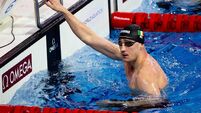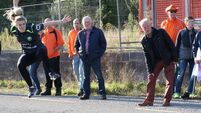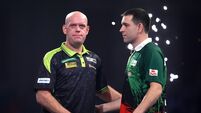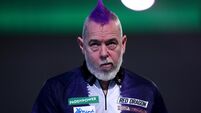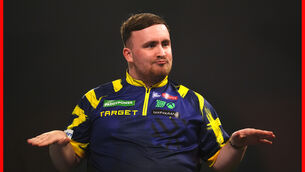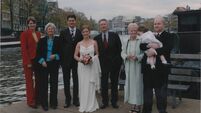Don't forget superman Larry Stanley, the high-jumping king among footballers
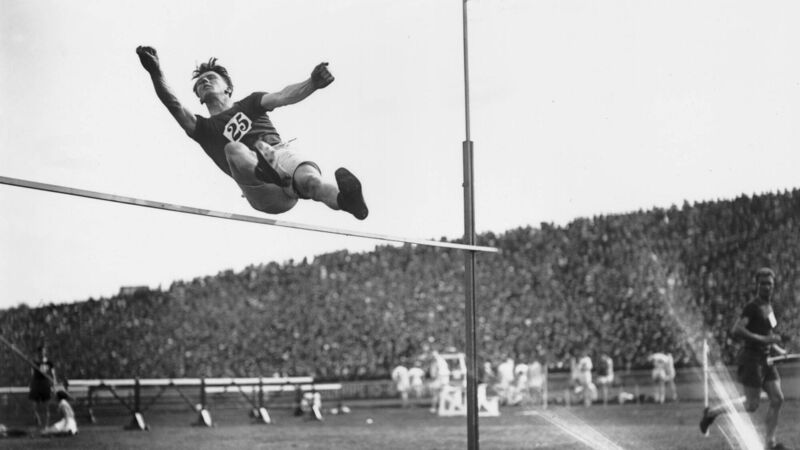
OVER THE BAR: Larry Stanley competing in the high jump during the Amateur Athletics Association Championships at Stamford Bridge. He went on to win the event. Photo: Coster/Topical Press Agency/Getty Images
There he is in all his glory, suspended in mid-air, leaning back with eyes closed as he clears the bar with all the apparent effort of a man sleeping off a heavy Sunday roast. Larry Stanley is grace personified as the athlete to the right of frame turns his head to join the thousands on the Stamford Bridge terracing in drinking in the moment.
If the ability to make great feats look easy is a measure of sporting greatness then AR Coster’s photo of the Kildare man descending towards the high-jump sand-pit at the British Amateur Athletic Association (AAA) championships this month a hundred years ago is vivid proof of the prodigious heights he managed.
This black-and-white image from the Getty archive survives as both timeless masterpiece and unique snapshot given it captures the then 28-year-old in the midst of a year – six months, to be more precise – which still stands a century later as among the most remarkable chapters in Irish sport.
From May to September 1924, Stanley won that AAA Championship, an inter-police event at the new Wembley Stadium and the Irish high jump title. He competed at the Olympics in Paris, gave a legendary display in the same event at the Tailteann Games in Croke Park, and won an All-Ireland senior football medal, with Dublin.
***
Fast forward to March, 1970 and the elderly Stanley was one of seven men captured in another photograph at Dublin’s Four Courts Hotel. In the shot with them was a framed gift from the Kildare Association based in the city, a beautiful, hand-drawn memento extolling a handful of his myriad achievements in two sports.
Half-a-century later John Lawler was rummaging around the endless attic that is the internet when he came across this very scroll on the Etsy website. The seller was a woman living Down Under, in the town of Buninyong, Victoria (pop. 3,797). He had to have it and have it he did, for the princely sum of €400, including post and package.

John Lawler made that purchase from Caragh, where Stanley had played much of his club football and just down the road from the great man’s birthplace in Blacktrench. John’s grandfather, Tom Lawler, had been back-up goalkeeper on the Kildare football team that Stanley had captained to an All-Ireland title in 1919.
Buying the scroll was just one act in a wider effort to remember, maybe re-remember, the area’s most famous son. On Wednesday, the Caragh Historical Society and Caragh Tidy Towns will hold a commemoration in honour of the great man in Fr Kinsella Park in the village green.
A lectern declaring his accomplishments will educate the generations and a stainless steel marker standing 6ft 3 1/8 inch has been embedded into the soil to serve as a visible representation of the bar he cleared during those Tailteann Games when he competed against a man labelled at the time as the world’s greatest athlete.
The Olympic Federation of Ireland will be among the honoured guests and it’s a timely project. Not just because it’s a century since he graced so many legendary venues across two sports, or because the Games return to Paris next month, but because Larry Stanley’s name and deeds had been slipping imperceptibly off the pages of history.
Time does that. His peak coincided with the revolutionary era in Ireland when events of much greater import than sport were dominating everyday life. Communication mediums hadn’t yet evolved to a point where the likes of Christy Ring would be immortalised by iconic stills and widely-available wireless commentaries.
“Maybe he was being lost because he didn’t have a rifle in his hand,” says Lawler who has put together an encyclopaedic file on the man. “He wasn’t a politician or a Republican. You lose the interest, the romanticism. You nearly have to shed blood at times to be remembered. I don’t want him to be lost.” He shouldn’t.
Among the attendees at the Four Courts in 1970 were TDs and Senators and Kerrymen who had battled with him time and again through the 1920s. Another guest was the serving general secretary of the GAA, Seán Ó Síocháin, who summed Stanley up as the “greatest footballer of all time”. A “king among men,” he said. This was not a controversial view.
Stanley became just the second footballer to be inducted into the Texaco Hall of Fame that same year. A decade later and he was the inaugural inductee into the GAA’s All-Time All Stars list (for players who played before the All Stars). Other notables include Tommy Murphy of Laois, Meath’s Peter McDermott and the great Sean Purcell of Galway.
A garda for three decades, he was voted posthumously onto the force’s all-time team in 2005 along with Cork’s John Kearns, Kerry’s Páidi Ó Sé and John Egan, and Matt O’Connor of Offaly. When the author Eoghan Corry published a tome on a century of Kildare GAA in 1984 there was only one man who would adorn the cover.
Numerous other writers have tipped their hat, among them Peter Matthews and Ian Buchanan in their 1995 book ‘All-time Greats of British and Irish Sport’. The doyen of GAA authors, Raymond Smith, devoted a chapter to Stanley in his 1968 book ‘Football Immortals’. But what was it that earned all this awe and praise?
Tales of his playing abilities were legion with various passages painting a picture of a man standing over six-foot tall and weighing north of 12 stone. Big for his day. He soared to prodigious heights to catch the ball, sometimes with just the one hand. His famed ball skills included a legendary point scored from out near the corner flag against Kerry in 1926.
“I had the natural spring of a high-jumper and I could clear over six feet,” he told the in 1970. “This obviously gave me a big advantage at midfield. I was also quick off the mark having won several prizes over 100 yards, but more than anything else I spent a great deal of time perfecting ball control.”
The astonishing thing about Stanley is that he played somewhere between 15 and 18 times for Kildare across a period of maybe 16 Championship years and yet he still made such an indelible impression. If there is any one game that speaks for the athlete then it is a drawn 1926 All-Ireland semi-final when he terrorised the Kingdom.
The Kerry poet Sigerson Clifford tells that one best in ‘The Ghost Train’.
“There's Con Brosnan running swiftly and our Sheehy shooting low
And Larry Stanley jumping sky high for the ball
It put the heart across me when the leather grazed our goal
And my throat with shouting tattered like a scraw
There was never sweeter music than that final whistle blown
And the board said, let me whisper, 'twas a draw.”
***
Tom Stanley’s attachment to Caragh, Kildare and an Ireland he first left 55 years ago is entrenched in a stubborn accent that betrays the merest of traces of New York as he touches base from his Yonkers home. The enthusiasm for his uncle Larry rings clear as day across 3,000 miles of ocean.
Tom is a treasure trove of anecdotes and tidbits that give colour to the history books. He remembers how his famous uncle would arrive down from his home in Rathmines – from a house where the word ‘Caragh’ was inscribed above the front door – to see his brother Mick and impart words of wisdom to the kids when it came to football.
Larry helped train Ballymore in 1953 as they completed an historic hat-trick of junior, intermediate and senior titles inside three years. And those earlier kicking and passing tutorials were complemented by gifts of team jerseys and when steeling the local Raheens team ahead of the club’s senior county success in 1964.
“The Friday night before the final we all met in the local school and he was talking about us being nervous,” Tom remembers. “And he said, ‘listen, that’s alright, if you’re not nervous then there’s something wrong with you’. It was a county final in front of maybe 6,000 people and we had never seen crowds like that before. It was great having him there.”
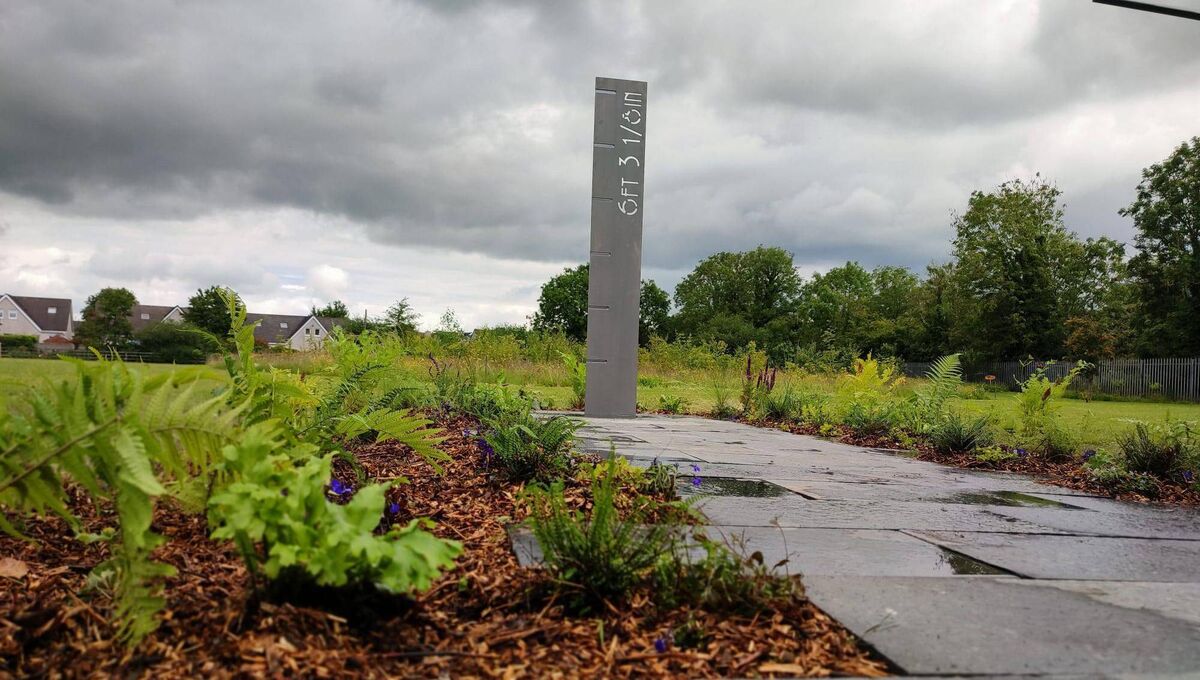
Most of all Tom remembers a gentleman, an unassuming teetotaller and non-smoker without airs or graces who only ever mentioned his own glory days when asked. But Larry Stanley could speak his mind and he did it through words and actions that were rarely trammelled by conventions.
Where to start?
Maybe with his penchant for athletics which, according to his nephew, took hold when a man keen on dating Larry’s sister Annie saw the youngest of the brood leaping over some gates and suggested he try it for real. Or maybe it's more apparent in a football career that saw him confined to the sidelines more than once, either by choice or by coercion.
He was, bizarrely, accused of ‘not trying hard enough’ in a challenge against Kerry in 1919, received a suspension from his own county board and went and played soccer instead for Donegal Celtic. In 1926 he walked away from the game in disgust after what he perceived to be unacceptably rough and targeted treatment at Kerry’s hands in that famous draw.
According to Tom, a sucker punch left him deaf in one ear.
That latter decision was a fateful one. It cost him All-Ireland medals with Kildare in 1927 and ’28 but the streak of independence was still strong in 1930 when, after an unexpected and triumphant return for the Leinster final replay against Meath, he declined the offer to follow it up in the All-Ireland semi-final against Monaghan. Kildare lost.
Larry told Raymond Smith decades later that he had agreed to face Meath after being caught on the hop with a last-minute request by the Kildare chairman. He scored 1-2 but noted later that he wasn’t as lithe a man as he used to be and so couldn’t be sure he would carry himself as well a second time around. He was his own man.
“He was a perfectionist. He’s the Roy Keane of his time,” says John Lawler. “He gave out too. In 1919, a few weeks before their All-Ireland final, he wrote a letter to the criticising his teammates for not having attended training. There was only maybe five training and three were from Caragh.”
The game itself didn’t escape his ire when the occasion demanded. A devotee of the catch and kick, he urged limitations on what he saw as the scourge of the hand-to-toe solo. And the man credited with that particular skill’s introduction? Mayo’s Sean Lavan, who was part of the same Irish Olympic team in Paris in 1924.
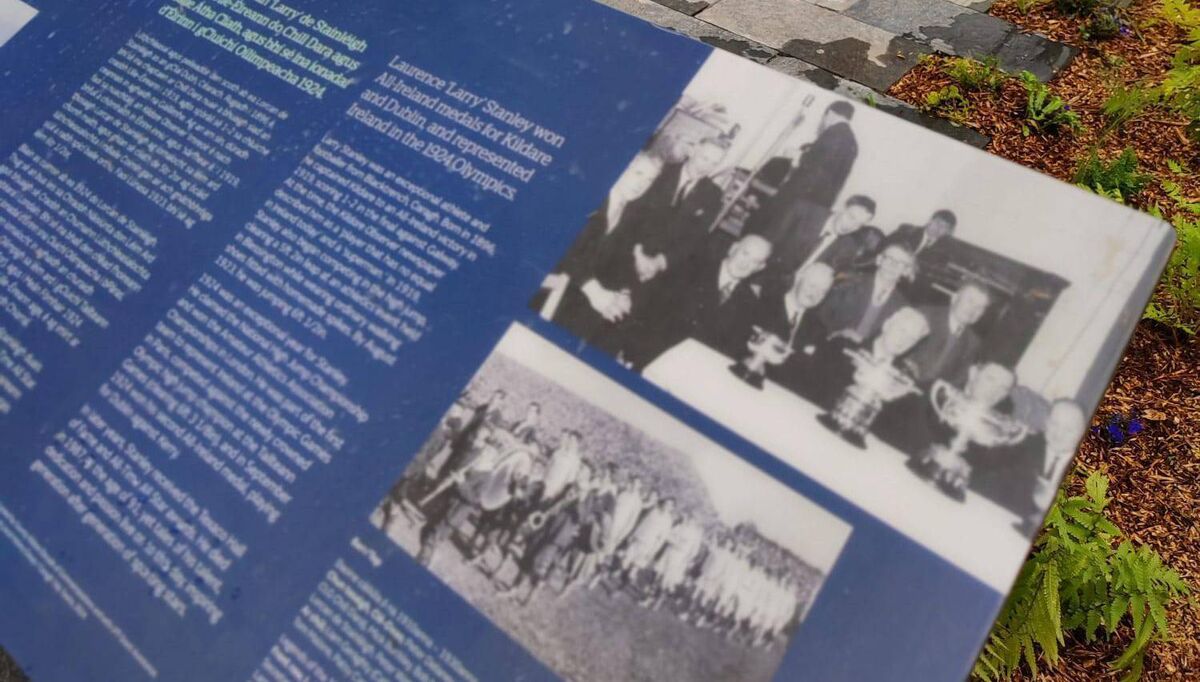
***
It’s the detours and the ditches that add such depth to Stanley’s story. The Stade Olympique de Colombes was one of them. His 5’ 9” jump fell well short of the 6’ 2” he had managed in Stamford Bridge and in the Irish championships. It placed him in tenth with Olympic gold going to the great Harold Osborn after a Games record of 6’ 6”.
Reports blamed the relatively unfamiliar cinder surface for Stanley’s display, and maybe the wet weather played a part. John Lawler wonders could it have been a simple case of nerves but, with the Irish soccer team playing two months before the opening ceremony, it still left Stanley as the first athlete to represent a free Ireland in track or field at an Olympic Games.
Within weeks he was competing against Osborn at those Tailteann Games in Croke Park, this time registering that 6’ 3” effort that came up just shy of the American after a heralded duel. Less than two months later and he was back at the same venue as one of three Kildare men in the Dublin forward line that beat Kerry to the Sam Maguire.
Stanley had been labelled a ‘superman’ by the after his starring role in the 1919 All-Ireland final. When he died in St Vincent’s Hospital after a short illness in October of 1987, almost 70 years later, another paper summed him up as “a giant in every sense of the word”.
On Wednesday, that life and those feats will be celebrated again by his people.





